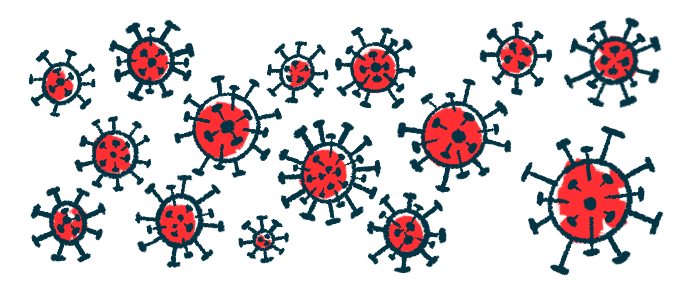SARS-CoV-2 infection rate no higher for Cushing’s patients, study finds
Prevalence of COVID-19 virus found to be similar to general population
Written by |

The prevalence of infection by SARS-CoV-2, the virus that causes COVID-19, was found to be similar in people with Cushing’s disease to that of the general population, according to an Italian study.
The same was seen for patients in Southern Italy with acromegaly, a disorder marked by the excessive production of growth hormone driven by a pituitary brain tumor.
Patients infected with SARS-CoV-2 were, in general, significantly younger than those without the virus. But neither sex, body mass index (BMI; a ratio of weight to height), nor diabetes were found to contribute to worsen patient outcomes.
Researchers noted, however, that “these results could have been biased by a safer behavior probably adopted by older and more complicated patients.”
The study, “Epidemiology, course, and outcomes of Sars-CoV-2 infection in patients with acromegaly and Cushing’s disease: a monocentric experience in Southern Italy,” was published in the Journal of Endocrinological Investigation.
Investigating SARS-CoV-2 infection prevalence in Southern Italy
Cushing’s disease and acromegaly are two disorders caused by the overproduction of specific hormones. People with Cushing’s disease have an excessive production of adrenocorticotropin hormone (ACTH), while those with acromegaly have too much growth hormone. In both cases, excessive hormone production is driven by a tumor in the brain’s pituitary gland.
In Cushing’s disease, the overproduction of ACTH leads to the excessive production of cortisol by the adrenal glands. That, in turn, results in the disease’s typical symptoms of weight gain, fat accumulation, and skin problems.
Both conditions have been associated with an elevated risk of infections. Moreover, infectious diseases are among the most common causes of death in Cushing’s disease patients.
However, very few studies have evaluated the course of infection by SARS-CoV-2 in these patients.
Now, a team of researchers at the University of Messina, in Italy, reported on the incidence, course, and outcomes of SARS-CoV-2 infection in patients with Cushing’s disease and acromegaly. All of the patients were followed for two years during the pandemic — from March 2020 to March 2022 — at the university hospital. Participants were from Sicily and the Calabria region in Southern Italy.
In total, the study involved 136 patients with a mean age of 55.7 — 71.3% were women. Among them, 76 had acromegaly and 60 had Cushing’s. Disease was under control in 108 cases (79.4%).
Pituitary gland function was impaired in 61.02% of patients. Nearly half (47.05%) had hypothyroidism, or an underactive thyroid gland, while 11.02% had hypoadrenalism (adrenal gland insufficiency), and 16.2% had hypogonadism (low levels of sex hormones).
Type 2 diabetes or impaired glucose (blood sugar) tolerance was seen in 30.1% of the patients, and high blood pressure in 61.02%. Cardiomyopathy, or disease of the heart muscle, was present in 60.3%. Additionally, in 41.6% of the patients with acromegaly, the disease was complicated by obstructive sleep apnea syndrome — a condition that causes patients to repeatedly stop and start breathing during sleep.
Sars-CoV-2 infection was found in 15 patients (11.02%). Infected patients were significantly younger than those without the virus, with a mean age of 46.8 versus 56.5. Infection rates were similar in acromegaly and Cushing’s disease patients (10.5% vs. 11.7%).
During the two years of the analysis, the Sars-CoV-2 infection rate in the general population from Sicily and the Calabria region was 14.7%, which is very close to the rate observed for both Cushing’s and acromegaly patients.
No significant differences were found regarding sex, BMI, and disease control between patients infected with Sars-CoV-2 and those without such infection.
We did not find a significantly different incidence of Sars-CoV-2 infection in [acromegaly] or [Cushing’s disease] patients compared to the general population.
The frequency of type 2 diabetes or impaired glucose tolerance was lower among infected patients than in uninfected ones (6.7% vs. 33.05%). Both groups had similar rates of high blood pressure, obstructive sleep apnea syndrome, cardiomyopathy, and hypopituitarism.
Among infected patients, three had asymptomatic infections. None required hospitalization or died.
Overall, “we did not find a significantly different incidence of Sars-CoV-2 infection in [acromegaly] or [Cushing’s disease] patients compared to the general population,” the researchers wrote, adding that prevalence “was not higher” among these individuals.
“Sars-CoV-2-positive patients had a lower average age than unaffected patients, but sex, BMI, or diabetes mellitus did not seem to influence disease susceptibility or worsen the outcome in our [study group],” the team concluded.






